Keep Deer Out of Your Garden – 5 Deer Deterrent Tips
This guide shares 5 tips to keep deer out of your garden, including repellent sprays, solid repellents, scare tactics, and fences and other barriers.
(A sturdy fence works best, but if the local deer population isn’t too aggressive, you can keep protect your plants without a fence.)

I’ll also share some tips to help you tell if you have deer damage or rabbit damage.
5 Ways to Keep Deer Out of the Garden
#1 Deer Repellent Sprays
Even though they may sample almost every plant, they have sensitive taste buds and a strong sense of smell. Deer dislike unpleasant flavors and smells.
Some of these deer repellent sprays are home remedies for keeping deer out of your garden, others can be purchased online or at your local garden center:
- Egg sprays – Blend together 6 raw eggs and 6 cups water and spray on plants. (The sulfur smell of the eggs keeps them away.)
- Pepper spray – Blend hot pepper or Tabasco sauce into water, strain (if needed) and spray on plants.
- Predator urine – You can purchase commercial “liquid fence” type products, or encourage your faithful pets to mark their turf around the areas you want protected. (Avoid food plants.)
- People pee – Given that we are predators (of a sort), peeing outside may indeed help discourage deer from entering a specific area.
- Peppermint extract – If you only have a small area to protect, this might work well for you. Purchase some mint extract (or make your own with excess mint). Mix in a ratio of roughly four parts water to one part extract. Spray on plants that you wish to protect.
- Combination sprays – Mixing your eggs and your peppers together will give deer a double whammy. Other recipes include sour milk, onion tops, dish soap, vinegar, clove oil, fish emulsion.
How to Use Deer Repellent Sprays
Reapply repellent sprays after rains, or every one to two weeks to deter deer. Rotating your sprays if possible, as deer have been known to develop a taste for spicy food.
#2 Solid Deer Repellents
While generally less effective than repellents sprayed directly on the foliage, solid repellents placed strategically around the garden may help deer proof your yard.
Options include:
Human hair or predator hair – I tuck hair around the tops of the raspberries. There, the raspberry thorns will catch and hold the hair for several days.
I’ve been applying the hair from the kitties’ grooming brushes there, too. You can ask for hair clippings at your local salon if you don’t have your own available to help keep deer away from your plants.
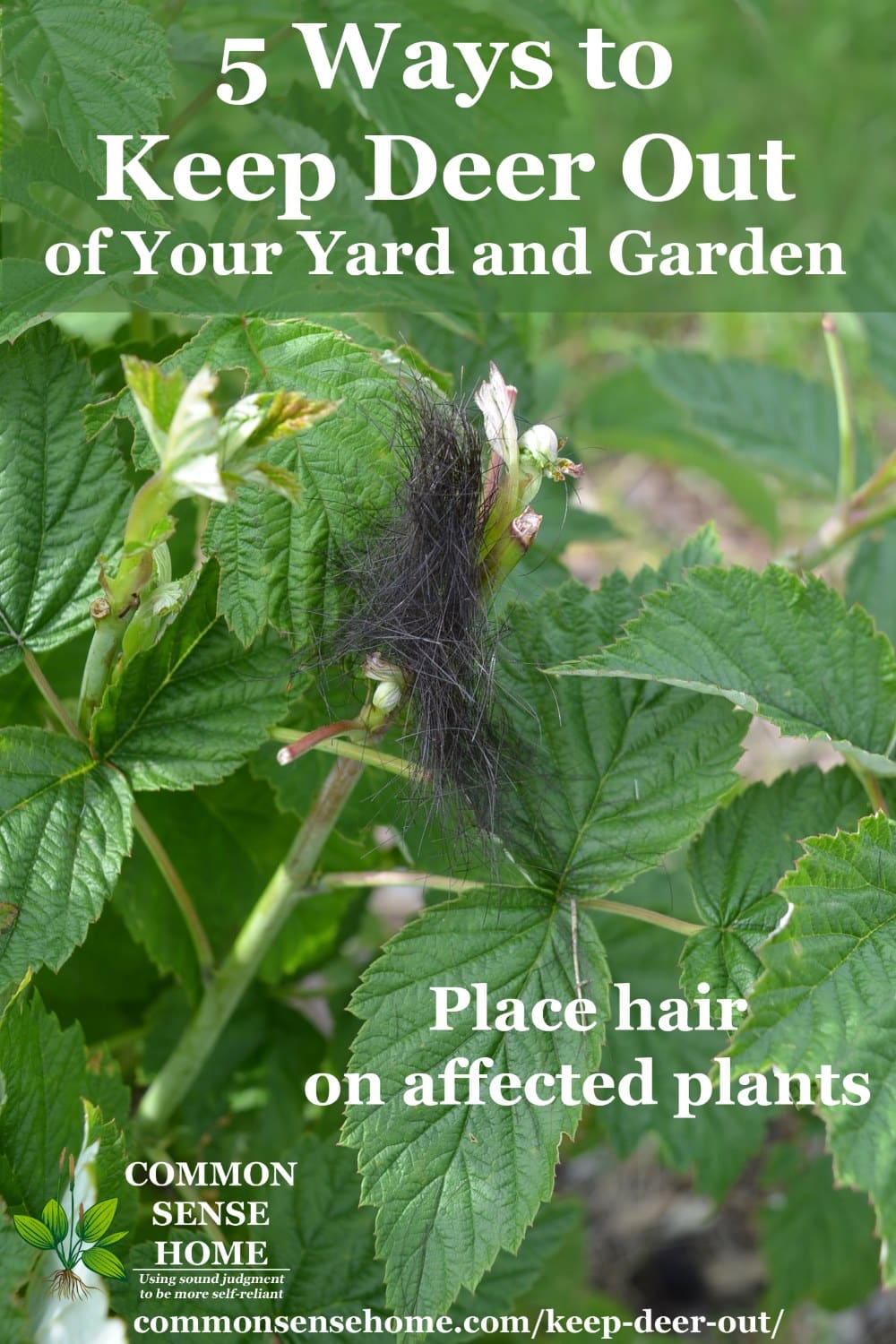
Bloodmeal – Sprinkled around plants, bloodmeal gives off an unpleasant odor that acts as a deer repellent.
Ivory soap – Many people recommend using soap to keep deer out of your garden. Unfortunately, although it’s been recommended for ages, placing bars of soap in socks around the perimeter of your garden is probably one of the least effective methods. You can try it, but I wouldn’t rely on it for full protection.
#3 – Scare Deer Away from the Garden
Random lights, noises and water sprays can scare deer away from your garden.
Motion activated lights or sprinklers to scare deer – We put a solar powered motion light out near the orchard. There are no neighbors nearby to get hit with the spotlight, and it’s handy if we need to go and check on that area of the yard at night.
Sprinklers may work even better, but I’d rather not waste water or water the garden at night and increase the risk of fungal diseases.
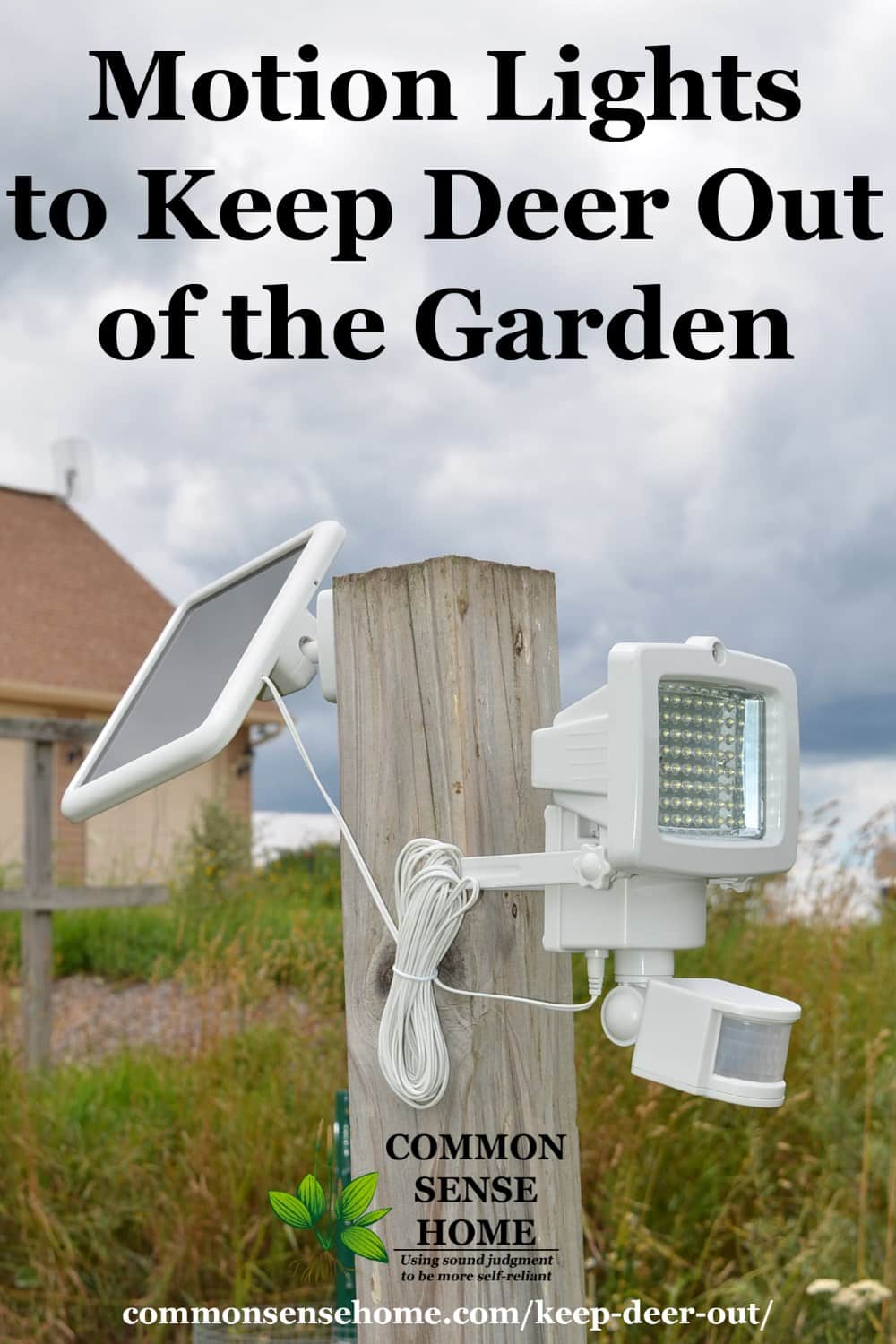
Noisemakers – I’ve placed several plastic grocery bags around the garden, and they seem to be helping. The changing noises the bags make when the wind catches them even surprise me, and I know that they’re there.
Wind chimes, pin wheels, aluminum pie pans or cans strung together on a wire or string can also startle your nocturnal visitors.
Commercial ultrasonic pest repellents are less likely to annoy neighbors while still getting the point across.
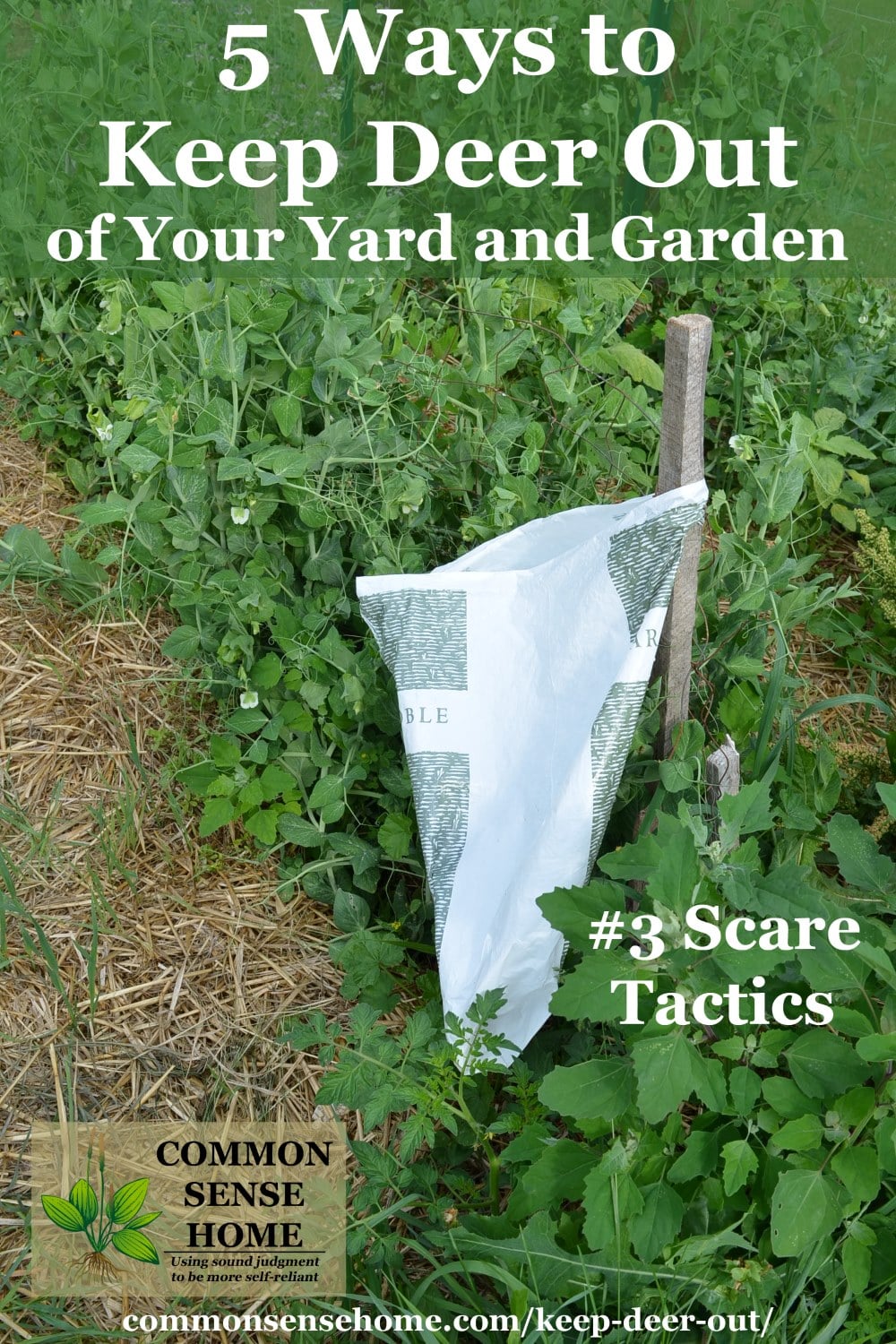
Dogs – Back on the farm growing up, my dog Mr. Pupper was on patrol every night. The barking was not so great, but we did get a harvest.
Barking alone is not likely to scare the deer for very long – the dog needs access to be able to back up the bark with bite if needed.
Would you like to save this?
#4 Fences (How to Choose the Right Fence Height)
While more work and expense than most of the solutions listed above, deer fences are one of the most reliable options available.
Keep deer out of a larger area (like a garden) where they can get a running start and have room to land on the other side, with an 8-12 foot tall deer fence. (White tailed deer require at least a nine foot fence.)
Using two fences instead of one allows you to use shorter, less visually intrusive fences. Pairing up two 5-6 foot tall fences 3 to 5 feet apart may do the trick to keep deer out. (Deer are better at the high jump than the broad jump.)
In our yard, we use 4 foot fences around individual fruit trees that are far from the house. With the fences places about 2 feet out from the trees, the deer can’t easily reach the trees. (As my eldest said, “They are not giraffes.”)
There’s not enough room for them to jump the fence without landing in a tree. We’ve also used 3-4 foot fences around shrubs. While they might be able to reach over those fences, they don’t seem to like putting their heads in a cage.
I have not used electric fences. Height and spacing is more important.
#5 Other Physical Barriers – Netting, Row Covers and Fishing Line
Try plastic deer netting, floating row covers or chicken wire to keep deer out of small vegetable garden beds, or away from specific plants or crops. These covers also help deter birds and other wildlife who want to sample your plants and/or fruit.
To use deer netting, gently drape it over the foliage to protect the bulk of the plant. You can also build a box frame over smaller plants.
My brother has a chicken wire cage topped with bird netting to protect his beautiful blueberry patch.
Does fishing line keep deer out of the garden?
Fishing line can keep deer out, if you use it correctly.
You can get creative and combine different techniques. For instance, try pairing fishing line with empty cans on top of buckets as demonstrated in the video below. The deer bump into the fishing line, knocking the cans off the buckets, which scares them away from the garden.
How do I know deer are eating my plants?
I see deer in our area all the time – usually at a distance, munching grass near the neighbor’s woods. But rarely catch one in the garden or orchard eating my plants. That said, I know for sure they’re in the garden due to specific signs of deer activity, including:
Damage – Chewed off Plants
Rabbits have munched our garden in the past. I’ve warded them off with garlic and herbs, which have worked pretty well.
I knew it wasn’t a rabbit problem this year because it was the tops of plants that were chewed off. Peas, beans, raspberries, jostaberries, fruit trees – all had shaved tops or one side of the trellis missing leaves.

Hoof Prints
Hoof print are difficult to see in mulch or grass, but soft garden soil can give a nice, clear imprint. Deer have a cloven hoof. A clear print will resemble two half circles. Often just the tips will push in on firmer ground.
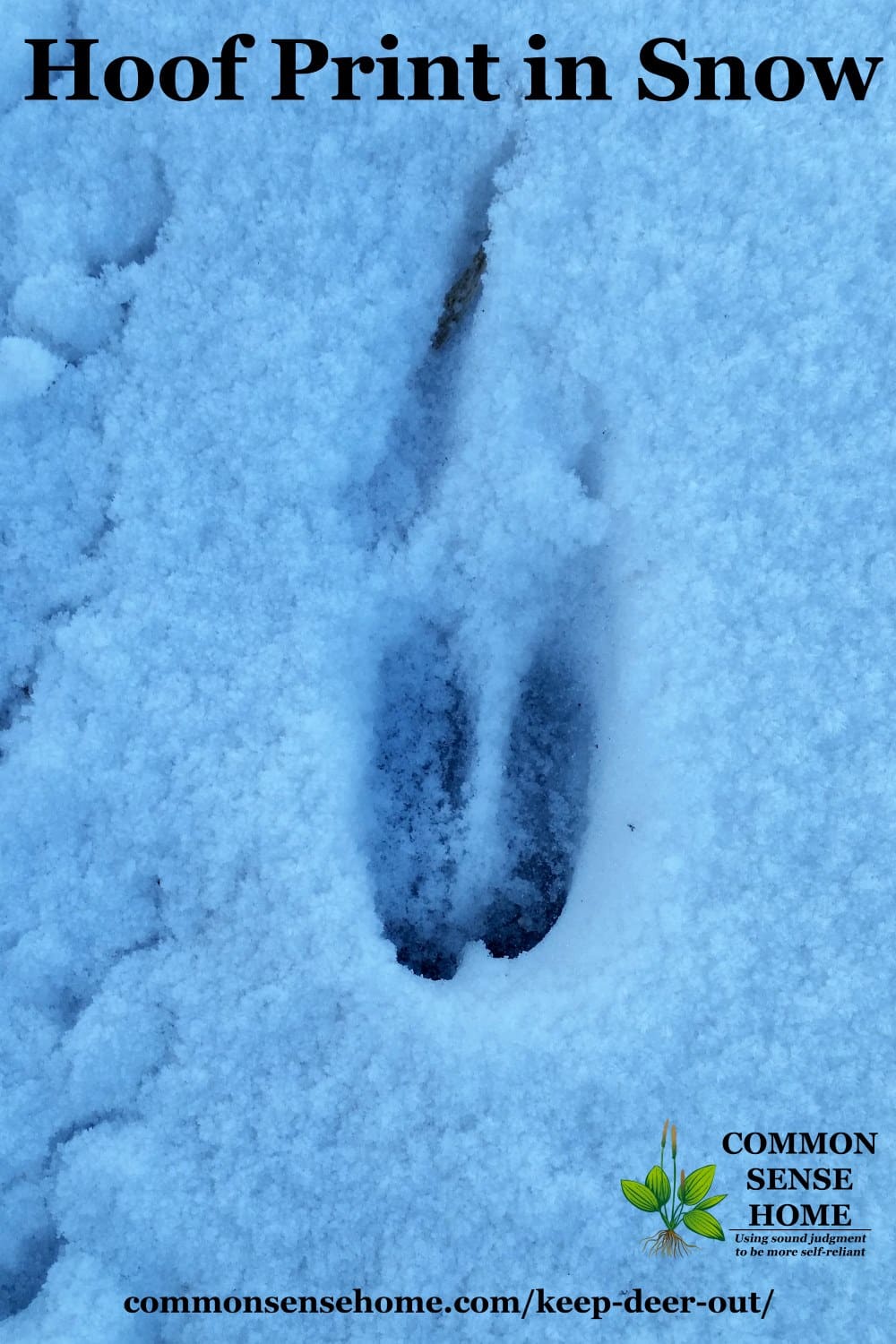
Trampled plants
Deer love peas, so they trampled my onions and bolting lettuce to get to the peas. I suspect the lettuce was too bitter for them to enjoy.
Droppings
My deer thoughtfully fertilized the lawn on the way out of the garden, so I was able to get a nice fresh photo of their droppings.
They resemble rabbit droppings, only bigger, with piles of individual marble sized poop nuggets.
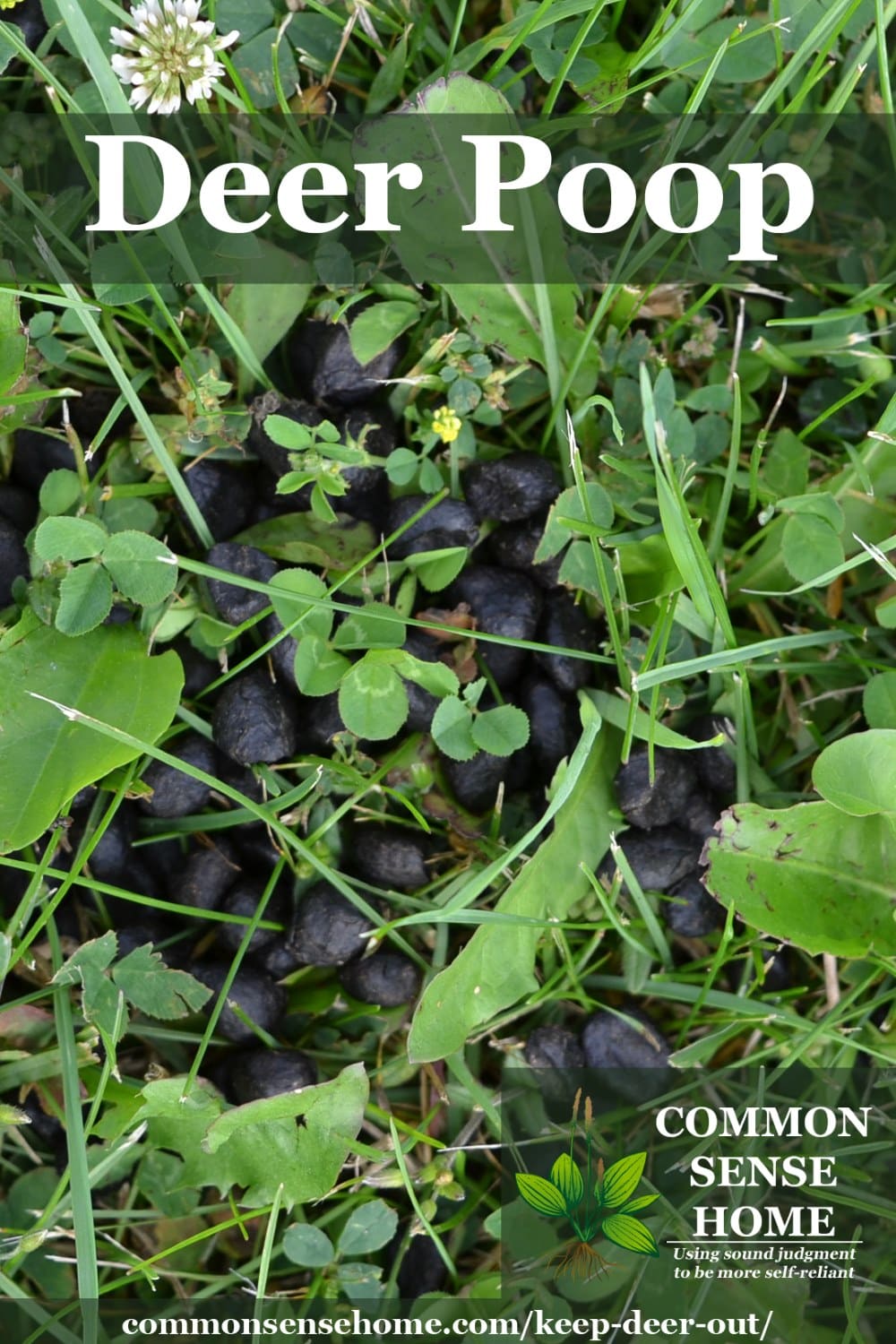
Did I miss any deer deterrent tips that have worked for you in your garden? Please leave a comment to share your experience.
You may also find useful:
- Homemade Bug Spray for the Garden – 3 Easy Recipes
- The Ultimate Guide to Natural Garden Pest Control
- New to Gardening – Start Here – 10 Tips for Beginning Gardeners
Originally published in 2016, last updated in 2020.

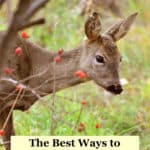

I have had pretty good success with a portable radio in a waterproof bag tuned to an all night radio station with the volume up really loud. It works as long as the batteries don’t give out in the middle of the night.
In our state (N.C.), you can get a permit to shoot out of season or have someone else do it for you if you don’t hunt, if the deer are destroying your crops.
I’ve used mountain laurel branches, fresh broken off the bushes, and hung in my fruit trees to keep the deer off. Replace when they dry enough they are not strong enough for the deer to smell them. This is a poisonous plant to them and they smell it and stay away. Worked better than anything I’ve ever used. Just don’t get their sap on your skin, it is very toxic and will make you feel like you’ve had a thousand bee stings.
Thanks for sharing your experience, and the use and warning on the mountain laurel. We don’t have it in our area, so I’ve never worked with it.
Similar to a couple of solutions here, Premier 1 Supplies suggests a simple double electric fence for deer, baited with scent caps to attract them to lick… once! There is a 3’ gap between the inner fence posts and the outer. The outer fence is a single strand at 34”, baited with scent caps. The inner fence is 2-5 strands, depending on deer pressure. Two strands at 20” and 48”, or up to 5 strands spaced to go higher for higher pressure. If you’re well-heeled, they have gobs of premade electric net fencing solutions, as well as almost all the other supplies you need for sheep, goats, and poultry. Not only is everything fully illustrated, diagramed, and explained online, but they also have free catalogs that you can keep on hand for visual reference. Here’s a link to their simple 3-D fence https://www.premier1supplies.com/img/fencing/diagram_pdf/31.pdf
I use a two fence solution for my cherry trees, which were heavily browsed on the lower branches. I wrap a small 3-4 foot (not sure) wire fence around the trees, both together, about 3-4 feet from the trunks, and then a taller fence, 5 feet high, about 3 feet out from that. When I just had the taller fence they were jumping over it to get closer to the trees.
Thanks, Carol.
Can you shoot the deer from your bedroom window? If so, deer meat for supper.
Just make sure the DNR doesn’t catch you if it’s not hunting season.
“They are not giraffes.” Haha that’s true, but we did spot the mule deer standing on their back legs to eat the leaves off the smaller, fenced trees in our backyard. Thanks for the tips; we will be planting some fruit trees next month and the deer are abundant and fearless around our place. I don’t think I can keep them from eating the low hanging fruit, but we may be able to use some of these techniques to keep them from hurting the trees until they get bigger.
Yeah, they can certainly be determined. We only deal with whitetails here. I’m sure the mule deer are even worse.
We have a 7 foot deer fence and feed carrots from our deck. They could jump the fence if they want to, but their carrot supply would be cut off. When I lived in Eastern Washington I used human hair, but in south western Oregon they hair didn’t deter them. I guess it is a game of trial and error depending on the deer where you live. Here we have both white tail and black tail, but thy are small.
We use Ag panels from the farm supply store. As long as we don’t make the fencing more than one Ag panel wide the deer see it as a trap and don’t jump in. We have a lot of rabbits too so wired chicken wire along the base of the panels. For the flower beds and smaller plants in the yard I bought garlic clips from Gardner Supply. You just punch a hole in it and clip it on your plant. Deer apparently don’t like garlic.
Interesting. I’ve never heard of garlic clips. Thanks for sharing your tips.
Try the garden commander! It was developed by a farmer tired of the deer eating his garden. They really do work both in traditional rows or raised beds. They are not expensive! Here’s a link if you are interested. http://www.gardencommander.com
I wouldn’t exactly call them inexpensive. $30 per 4 foot long 2 foot tall row could add up pretty quickly, but if you had a small garden with everything planted in skinny rows, they could work.
I live in washington I have 4 raised beds not fenced. I have a wind pin wheels at each end of the beds, I have 1 wind chime, and motion solar lights. I also plant marigolds and cosmos in each bed. The Apple tree right next to the raised beds gets trimmed every year n they eat the bottom Apple’s but they don’t eat my garden. I have often wondered why…
Sounds like you’ve found a good combination of deterrents.
My mom is a part time hair dresser and we use hair clippings in the garden. The deer don’t like the smell of humans so it deters them. It’s a natural and safe way to protect the plants. 🙂
I use the two fence system. Inside fence is just 4ft.which works for rabbits also. The outer fence is an electric wire about 5-6ft. out from the the inner one. In the spring I twist tinfoil tightly around the wire in many places, of course do this when turned off, then I put peanut butter on the tinfoil. They learn very fast to stay away. I’ve used this method for many years. It really does good. 🙂
I like the peanut butter on the tinfoil. Good way to get the point across.
Right now, I don’t have much of a garden. I have deer that come and eat the windfall apples, but that will have to change when I start harvesting all of the apples for myself.
When I do plant a garden, I have several ideas in mind for deterring deer as well as other pests:
I’d like to plant in boxes and have them covered on all sides and the top with some sort of netting that allows light, but not birds or deer. I also just invested in a box of whirlygigs…those pinwheels that turn in the wind for my fruit trees…something that can’t be protected by netting on the top…
they were pretty inexpensive from Oriental trading rather than Amazon, which were really expensive! You do have to put them together, but that isn’t hard at all.
These are two of my ideas.
My Father-In-Law used blood meal for keeping the deer at bay. It really worked. He had a farm and it kept them from the corn, melons and tomatoes pretty well.
Thanks for sharing, Carol.